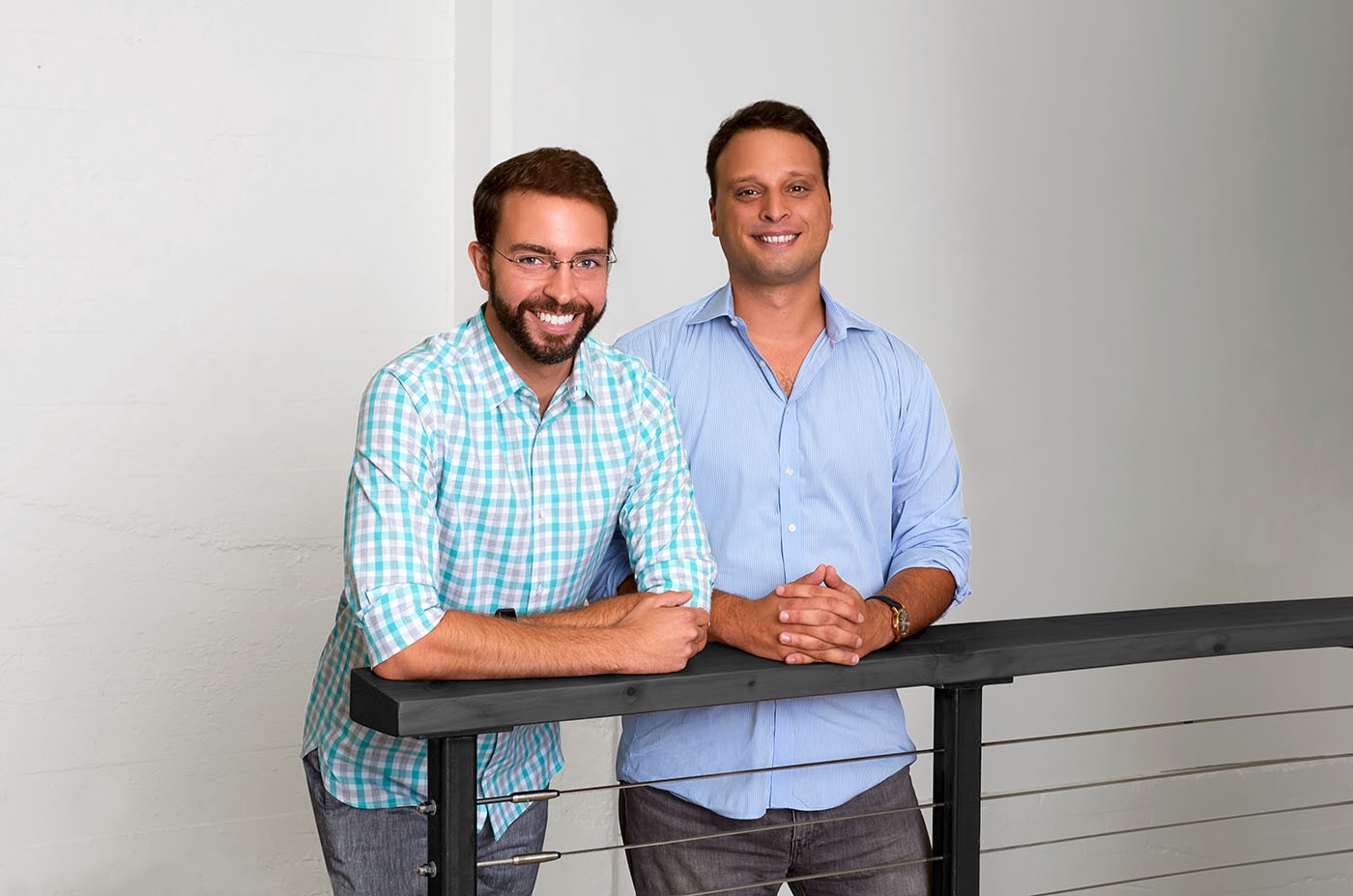Periscope Data is emerging as a quiet juggernaut, one of those rare, ultra-relevant startups that also packs a ton of heart and hustle. How exactly did co-founder and CEO Harry Glaser and Tom O’Neill do it? Well, we’ll let him explain.
Few founders find the perfect co-founder, leave the comforts of corporate America, and turn a side hustle into a business that later raises millions–$34.5 million to be exact.
Harry Glaser and Tom O’Neill are the co-founders of Periscope Data, the world’s leading analytics platform for data professionals and businesses. In 2012 the former college roommates discovered a business idea that worked–turning big data into actionable insights to create real business impact. A side project that today is trusted by more than 1,000 customers including Adobe, Crunchbase, ZipRecruiter, HBO, and Uber––to name a few.
Periscope Data was recently ranked No. 4 on Deloitte’s Technology Fast 500™and has grown more than 23,000 percent in the last three years.
So what’s the secret to their trajectory?
Glaser talked with YFS Magazine about cycling through terrible ideas, landing their first sale, raising their first million, tech diversity, and building a scrappy San Francisco-based startup poised to disrupt the world of business intelligence. And doing it all without an initial master plan.
From side hustle to seed funding
YFS Magazine: How did you come up with the business idea for Periscope Data?
I started the company with my co-founder Tom O’Neill. He’s our CTO, and we’ve known each other for about 15 years. We were college roommates at the University of Rochester.
After graduating in 2007, I spent a little under four years at Google as a Product Manager. Tom spent four years at Microsoft working on the machine learning algorithms behind the search results at Bing.
After Google, my whole plan was, “I’ll start anything at all… as long as it’s with Tom.” He was and is the best engineer that I know. I worked with all of these senior Google engineers, and I still thought Tom was the most talented engineer that I ever met. So, I thought “Someday he’s going to change the world, and if I’m standing next to him when that happens, then I can take half the credit, and that’ll be really good for me.”
So I convinced him to start a company. Eventually, I succeeded, and he moved from Seattle to San Francisco, and we started a company. We had no idea what we were going to do. We cycled through several great ideas that all turned out to be terrible ideas.
“We don’t have to pretend like we had a master plan from the beginning.”
Periscope was actually a side project. We built it so we could look at the data from different things we had built that were out in the market. A friend saw what we were doing and asked if he could use it too. I said sure and thought maybe I could open source it, so I sent him the source code.
He said, “I have a real job. I don’t have time for this. Can I just pay you?” I said sure and tried to make up a number that would extend our runway a little bit. So I said, “Okay, twenty grand.” He goes, “No problem. Send me an invoice.”
At that point, I’m googling how to send an invoice. When that happened the second time, I was like “All right! Now we’re in business. This is it.” We pivoted the focus entirely to Periscope, raised some seed funding, hired a couple of engineers that I worked with at Google and we were off to the races.
YFS Magazine: Many entrepreneurs stumble upon their ideas by accident. It seems the same is true of Periscope Data?
Yeah, I think we all owe a debt to Slack CEO Stewart (Butterfield) who I think was the first one to publicly tell the story about his billion dollar startup idea being a total accident. Now all of us who have done the same feel a little safer saying that out loud. We don’t have to pretend like we had a master plan from the beginning.
Cracking the co-founder code
YFS Magazine: Entrepreneurs have a difficult time finding the right co-founder. How has finding the right fit with Tom impacted your startup journey?
Yes. This is, I think, a really critical point and probably not talked about enough. We had a lot of trust and history in our relationship before we ever started our company.
It’s really important that your first fight as a “couple” is not about the company. It’s like having your first fight be about the kids. That’s the problem, your relationship needs to be a lot more stable before you have the kids.
I see a lot of seed stage companies fail and much of that failure stems from co-founder fights. They disagree about the direction of the company, and the whole company fails. We didn’t have that problem because there was a lot of history and trust already.
Hacking growth one blog post at a time
YFS Magazine: How did you build your customer base from day one?
Periscope Data has largely grown by word of mouth and very little marketing. It has picked up steam in an impressive way. We tried a lot of things initially. What ended up working for us was selling the data and also …. (we’d write these) blog posts.
They were very technical and addressed to our audience in a way they could actually learn from. We would write these blog posts about how to do analysis, with a lot of technical detail and code and we would publish them.
People would read them and typically after reading two blog posts, they would sign up for the product. Then I would call them back and try to sell them.
“I was a terrible salesperson when we started… It took me three or four months to finally make a sale.”
I was a terrible salesperson when we started. I have an engineering background. We launched and got a bunch of inbound leads from these blog posts. It took me three or four months to finally make a sale. I learned how to sell by reading posts about it and asking my friends who had gone through this transition. We eventually got there.
YFS Magazine: You leveraged inbound marketing from day one which is something that a lot of technology entrepreneurs don’t do. Is that problematic for technical founders?
Focusing on the product in the early days to the exclusion of sales and marketing is a mistake a lot of technical founders make. Many have never been in a role where they actually have to go sell the thing.
They’re used to building, and it’s easier for them to build. That’s a mistake. I know some people who do focus appropriately on sales but start outbound to your point. They’re cold calling and that works well too.
Inbound has its pros and cons. It’s a lot less predictable. Will the blog post succeed or not? You don’t know until you try it. You have a string of three or four failed marketing attempts in a row that can make it harder to hit a sales number where outbound can become very mechanical. On the other hand, it’s typically cheaper to do inbound and easier to make the sale – not to mention it’s faster.
Moving upmarket and riding trends
YFS Magazine: How has your marketing strategy evolved since those early days?
We still do the blog posts and they still work well. We do some paid advertising in a bunch of channels and that works pretty well. But marketing now is much broader and more strategic than it was then.
So we do press and a lot of brand stuff now. We create content pieces for all audiences as we’ve moved upmarket and we’re selling to larger customers now (e.g., HBO and Uber, who are both customers).

It’s not just talking about data analysis with our technology. We’re talking to their CEO about the transformation Periscope Data will bring to their company. That’s a very different medium and it’s a very different kind of message than the one to data analysts.
YFS Magazine: Your customer base has evolved as you work with more large enterprise customers. Was that your goal from day one?
Once we figured out what we were doing, we knew we wanted to reach data teams in every company across the world over time. So the question just becomes which companies do you attack and when.
We’re riding this trend of data analysts and data scientists playing a much bigger role in their companies across industries. Since all trends start with the early adopters including startups and small companies, we hit those first.
Data scientists at some companies have grown huge, like Uber. And companies like HBO are starting to acquire these teams because they need to compete effectively with Netflix. So given this trend, it makes sense for us to go after these companies as well. That shift changes our marketing and our sales approach.
Selling SaaS to SMBs vs. Enterprise Customers
YFS Magazine: What’s the transition been like going from educating customers to a market that is well-informed on big data and their need to harness it more effectively?
It’s different. In some ways, early adopters are easier because they’re passionate and forgiving of mistakes, and they like to try new things. So you can go in there with a very early-stage product that may be half baked in some ways but has a new capability, and they’re excited to try it out. That said, it’s pretty evangelistic, and it’s pretty hit or miss.
Selling to a large company is just more challenging. It takes longer, it involves a lot more people. You have to be much better at sales. It also takes longer to educate the whole company about the value you can bring to them.
I do think we’re in a world now where there’s no doubt they need these capabilities to stay competitive. So that part is much easier than it used to be.
Bootstrapping and raising the first $1.5 million
YFS Magazine: In a little over six years, you have scaled a side project into a thriving company with 138 employees. Tell us about your journey to the first $1.5 million.
We bootstrapped, by which I mean, I lived in Tom’s second bedroom and ate Ramen, for about a year. And then we raised est. $1.5 million and that lasted us another two years.
We were really frugal that whole time while we were innovating and trying to grow. Then we were off to the races, and we started raising tens of millions. But that was after the business had gotten quite successful.
“Raising that first million was pure hustle… We weren’t well-connected.”
We raised money at the worst time of year, which is between Thanksgiving and Christmas. It was horrible. We weren’t well-connected. I knew a few people from Google, and we used them, their connections, and third-degree connections. Raising that first million was pure hustle.
At every meeting, I asked for them to introduce me to somebody else. We stacked it up and did four or five pitches a day for three weeks. After 70 pitches we got 25 yeses. So we got a lot of no’s.
I remember we set the goal to raise a million and by Wednesday of the third week, we were at $400,000. I thought we were screwed. My old boss from Google, Marissa Mayer, who was the CEO of Yahoo at the time, said yes. Then all of a sudden everyone wanted to invest because Marissa was investing. As a result, we overachieved and raised 1.5 million in the next two days.
And I flew home for Christmas.
Pitch decks and grit
YFS Magazine: If you’re new to fundraising it’s hard to know how to correctly pitch an investor. Can you offer entrepreneurs some advice?
There’s a lot of good advice out there for pitching investors. Know the customer problem cold, know the solution cold, know the market cold, and get it done in eight to ten slides.
I see a lot of pitch decks that are 30 slides with endless technical detail. It’s a sales pitch. You’ve got to be compelling, you’ve got to be quick.
You need a lot of grit. It’s going to get harder. You’ve got to be able to endure fifty no’s in a fundraising round. I see a lot of seed-stage companies fail because the founders can’t take it anymore and give up. Adopting a don’t give up attitude can get you pretty far.
Tackling tech diversity and culture
YFS Magazine: Looking back, what hard-won lessons did you learn along the way?
Oh, man! I learned all things the hard way. I’ll tell you when we started the company we hired from my network and Tom’s. Our friend groups are pretty homogenous, and we got up to six or seven white guys. It started to feel not so great–the culture was not great either.
I placed a six to twelve-month freeze on hiring white guys, and we forced the culture to change so people from underrepresented backgrounds would be willing to join our company. We were successful at that eventually.
“I placed a six to twelve-month freeze on hiring white guys, and we forced the culture to change so people from underrepresented backgrounds would be willing to join our company.”
It was a hard process but ended up being really beneficial for the culture. We became a much more inclusive and welcoming. It shows now in our diversity, but that wasn’t always true. We learned that the hard way.
I remember thinking if this gets to 10 (white guys) we’ll never be able to hire anyone, we’re toast. We’re going to be one of those horrible companies that’s skewed and still fighting a diversity problem years later.
YFS Magazine: What does it take to create a truly inclusive tech company culture?
First of all, you have to be proactive and intentional and decide what you want the culture to be. You’re constantly gardening, pulling weeds, encouraging the growth of things you want to grow and keeping an eye on it every day. At some point, it moves from being the founder’s project to the whole team’s project.
The whole team owns the culture. It’s this shared garden of sorts that we’re all working on together. Let them make that change, give them ownership and let the culture evolve.
Culture becomes toxic when founders and early employees hang on to the way it was in the early days. They want it to be that way forever, and it’s exclusionary to new people. It can turn these weird quirks into company obsessions.
Leadership lessons and embracing change
YFS Magazine: What’s something you’ve learned that you lean on daily as an entrepreneur?
Early on I learned as a co-founder and CEO at a high-growth company you have to change every six months or so. You’re selling one day, building the next, hiring the next day, and doing finance the day after.

People get stuck when they do the same thing they did a year ago. They’re not growing. Your role as a CEO changes enormously as the company grows. You have to embrace it.
YFS Magazine: What small personal change have you made that has made a big difference in the way you work?
Working out every morning. For my mood and my stress levels more than anything. I recommend that to every CEO I meet too. It helps me get my head right every morning before I go to the office.
Vision and scaling on the horizon
YFS Magazine: What’s next for you and Periscope Data?
The next things we are doing are mostly about scale. The trend (for deeper and improved insight into big data, powerful analytics, and business intelligence) is now impacting larger legacy companies.
So we want the product and sales to scale as we meet the needs of this growing customer segment. So that will include new features that allow users to apply Periscope to much larger organizations. We are also focused on scaling our own organization over the next 12 to 18 months.
I think you should always extend your vision. We are looking at what will be the next thing and what trends will propel the business forward.
When asked his number one tip for entrepreneurs, Glaser’s answer is simple: “Don’t quit.”
© YFS Magazine. All Rights Reserved. Copying prohibited. All material is protected by U.S. and international copyright laws. Unauthorized reproduction or distribution of this material is prohibited. Sharing of this material under Attribution-NonCommercial-NoDerivatives 4.0 International terms, listed here, is permitted.




